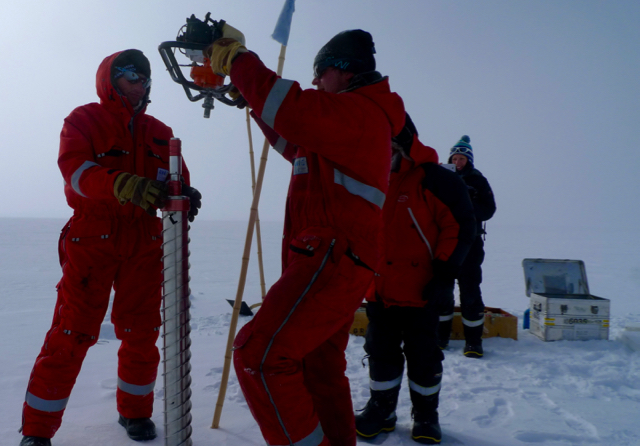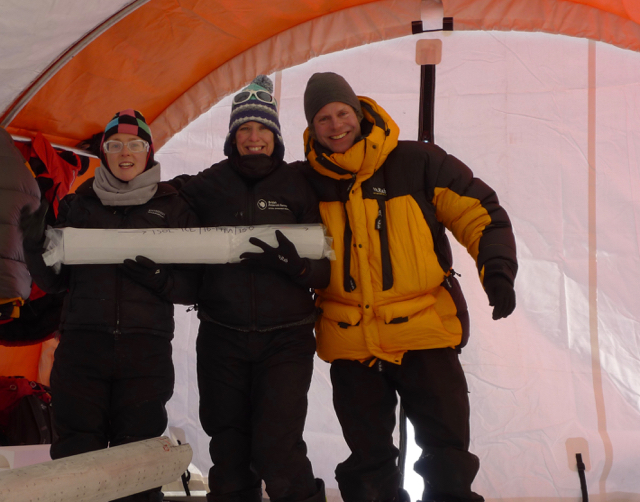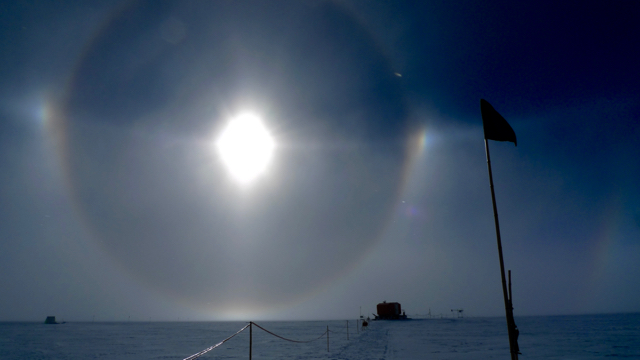ANTARCTIC BLOG: Working on the Polar Plateau
7 February, 2017
A new blog post from atmospheric and glaciochemist Markus Frey who’s working on the Polar plateau as part of the ISOL-ice research project. Read the team’s earlier post here
Kohnen Station 75ºS 0ºW, 2890 m amsl
13/01/2017
An important part of this project is to drill an ice core to a depth of 120 m which will be transported back to Cambridge for initial chemical analysis in our suite of ice core laboratories at BAS. Ice cores are unique records of past climate. In polar regions (e.g. Antarctica) where the average temperatures remain below 0o C, there is little surface melting. Therefore, each year the snowfall becomes compressed into ice forming a continuous record of annual snowfall and of the atmospheric conditions at the time of snow deposition. Ice cores drilled in Antarctica are used to reconstruct past climate, as they reveal historic records of e.g. snow accumulation, volcanic eruptions, marine biological activity or as for this project a unique record of UV radiation.
Ice core drilling is a large complex operation to firstly get the equipment out into the field, assemble it, drill intact columns of ice and then process the collected ice for analysis and transport back to the laboratories for further analysis.
The ice core drilling first involves putting up a large tent (very useful when tall people are available to lend a hand), which enables us to drill in most weather conditions. The tent comes complete with a hole in a roof. This is not a mistake but accommodates the mast, which in conjunction with the winch is used to hoist up the drill from the drilled depth and bring up the drilled ice. The drill itself is transported in segments (anti-torque, motor, outer barrel, inner barrel sections and the drill head), which we assemble when at the chosen drill site. The barrels enable us to drill and collect the required 120 m core of ice in approximately 0.7 – 1.0 m intact sections. When a 1.0 m section has been drilled, we winch the drill up, release the inner barrel and push the 1.0 m column of ice out. The drill is then sent back down the bore hole to drill down a further 1.0 m. For every 1.0 m of ice collected we record the weight, length and diameter. These measurements are important to calculate the density of the ice. We then cut with a saw the intact columns of ice into sections, seal them in labelled bags and store in boxes ready for transportation.

The drilling team (Markus, Holly and myself) started off very well. The first challenge is to get to a drilling depth in which the anti-torque section of the drill can activate and stop the drill barrel twisting in the bore hole and to use drill parameters that enable drilling though snow that is not yet compressed fully into ice (firn). The drill team started well, drilling and retrieving beautiful sections of firn and were all speed ahead. Surely drilling to 120 m will be a doddle? But then we hit a drill depth of 12 m. Yes only 12 m and the challenges began. Oh No!
At 12 m the drill could no longer penetrate into the ice deeper. Why was this? After scratching our heads, using our previous experience and consulting BAS ice core drilling experts (Robert Mulvaney and Julius Rix) on the bat phone (email) there was a simple solution and the problem was quickly resolved. We were also extremely fortunate in that here at Kohnen station there is a lot of drilling expertise and the station staff are always so helpful. As mentioned in a previous ISOL-ICE Blog, Kohnen is a historical drill site.
During the drilling process, the drilling team came across a few challenges such as leaving sections of ice down the bore hole, the drill not penetrating, broken ice within a drilled section (very bad for further analysis) and only drilling very small sections of ice (4 cm). All these challenges were overcome by changing drill parameters such as anti-torque blades, core dogs (help break the core and retain ice in the barrel as we winch the drill up) and keeping the drill cutters sharp.

Eventually the team successfully drilled to 120.44 m, which should give us an archive over 1300 years. Since we liked the drilling so much and in fact wanted to recover enough sample for the recent 60 years we drilled two more 10m cores using a hand drill provided by AWI.
The ice (kept frozen of course) and drilling equipment will now travel back to the UK by ship ready for the next project challenge (chemical analysis).
Kohnen Station 75ºS 0ºW, 2890 m amsl
19/01/2017, air temperature -22ºC, wind speed 8 knots, some high clouds
I hardly notice the vibration of my phone alarm at 6:25am because of the constant noise of several air pumps pulling cold air into the chemical detectors running round the clock. I had decided to spend the night in the biwak shelter to give the pilots of the Polar 6 Basler airplane, which arrived yesterday some space in the red Weatherhaven tent I usually sleep in. But now I feel more like having spent the night at a busy train station … however I quickly forget last night when I open the door of the biwak shelter to walk into a chilly morning and slowly recognize a spectacular display of halos around the sun. This is one of these days, when the endless flat white open space around us is embellished by a colourful spectacle in the skies above.

I start remembering some details from the atmospheric physics class I took in the early 2000s at the University of Arizona on how hexagonal plates and columns of ice suspended in the air refract and reflect the rays of the sun above to cause such colourful arcs. In the radio room of Kohnen station I luckily find a book on halos to refresh my memory and to identify the arcs visible today above Kohnen. Unlike our ancestors back in the 17th century who associated halos with some natural catastrophe or plague to be sent by some higher power I know better now: it’s simply another beautiful day in Antarctica.